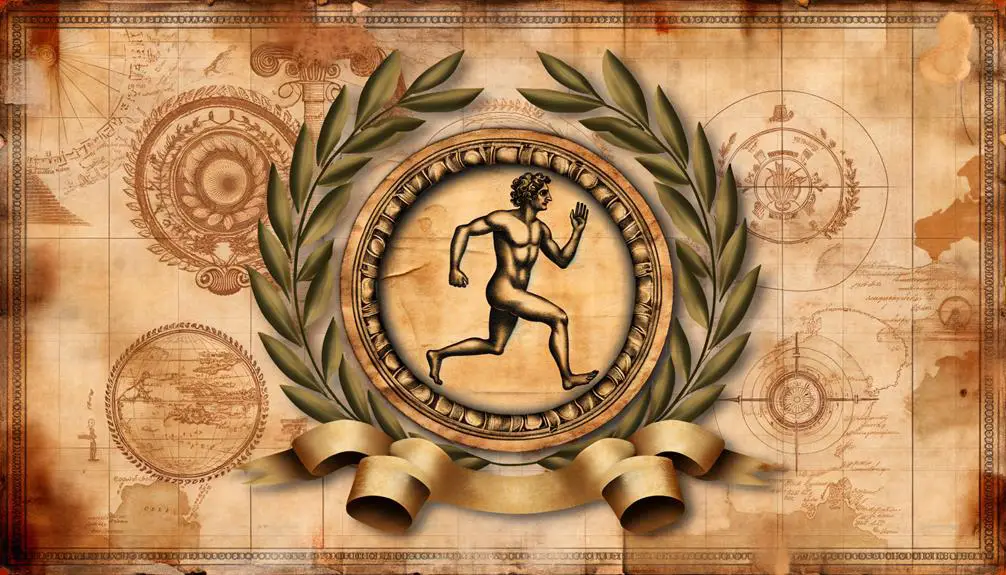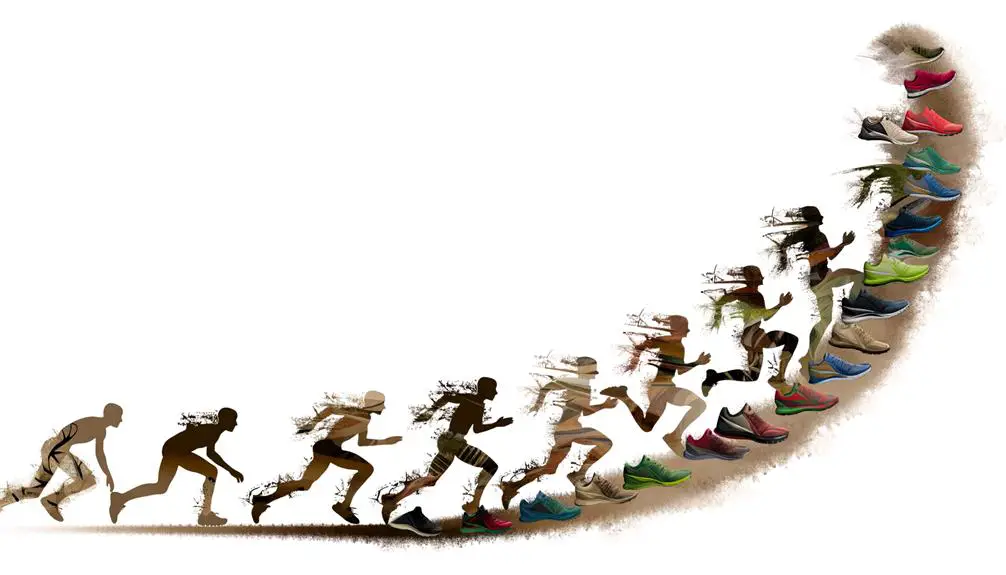Which Symbol Best Represents Cross Country Running?
The symbol for cross country running is a dynamic representation of endurance, resilience, and the pursuit of personal excellence. Originating in 19th-century England, the sport evolved from schoolboy games into organized competitions, shaping a rich heritage.
It embodies the spirit of overcoming obstacles and maneuvering life's unpredictable terrain. Modern cross country running integrates technological advancements in apparel and gear, enhancing performance and comfort.
Globally, the sport promotes physical fitness, camaraderie, and mutual support, celebrating human tenacity. This multifaceted symbol highlights the profound connection between nature and human perseverance, revealing deeper insights into the essence of cross country running.

Key Takeaways
- Footprints or Shoe Prints: Symbolize the journey, effort, and terrain of cross country running.
- Running Figure: Represents the athlete's motion, endurance, and determination in the sport.
- Hills and Trees: Reflect the natural landscapes and challenges typical in cross country courses.
- Finish Line or Ribbon: Signifies the goal, achievement, and completion of the race.
- Clock or Stopwatch: Emphasizes timing, performance, and the competitive aspect of cross country running.
Historical Origins

The historical origins of cross country running can be traced back to 19th-century England, where it evolved from a schoolboy game known as 'hare and hounds.' This game involved a 'hare' laying a trail of paper shreds for the 'hounds' to follow over varied terrain, combining strategy with endurance.
It gained formal recognition in 1837 when Rugby School held its first cross country race. By 1876, the sport had organized rules and a governing body, the National Cross-Country Union, was established. This evolution marked the shift from an informal pursuit to a structured athletic discipline.
The sport quickly spread beyond school grounds, becoming a popular competitive activity that tested an individual's stamina and resilience across natural landscapes.
Symbolic Meaning
Beyond its physical demands, cross country running carries profound symbolic meaning, representing the human spirit's resilience and the pursuit of personal excellence across challenging terrains.
This sport epitomizes endurance and determination, as runners navigate diverse landscapes that mirror life's unpredictable nature. The act of traversing fields, forests, and hills is emblematic of overcoming obstacles and embracing the journey rather than just the destination.
Cross country running fosters a sense of camaraderie and collective endeavor, echoing the importance of community and mutual support. It underscores the value of persistence, highlighting that true achievement is born from sustained effort and unwavering commitment.
Ultimately, the symbolic essence of cross country running lies in its celebration of human tenacity and the relentless quest for self-improvement.
Design Evolution

Design evolution in cross country running attire and equipment has greatly advanced to enhance performance, comfort, and safety for athletes navigating diverse terrains.
Modern running shoes now incorporate advanced materials and designs that provide optimal traction and cushioning, reducing the risk of injury on uneven surfaces.
Moisture-wicking fabrics in apparel keep runners dry and comfortable, while lightweight, breathable layers offer protection against varying weather conditions.
Technological advancements have also led to the development of GPS-enabled wearables, allowing athletes to monitor their pace and route with precision.
Additionally, ergonomic design improvements in hydration packs and gear ensure minimal distraction and maximum efficiency.
These innovations collectively support athletes in achieving their peak performance in the challenging sport of cross country running.
Global Recognition
Recognized worldwide, cross country running has captivated athletes and spectators alike with its unique blend of endurance, strategy, and connection to nature. This sport, which traverses diverse terrains and often unpredictable weather conditions, has earned a significant place in global athletic culture.
Major international competitions, such as the IAAF World Cross Country Championships, showcase elite talent and bring together participants from various countries, enhancing its global stature. National and regional championships further bolster its widespread appeal, fostering a strong community of enthusiasts.
The universal recognition of cross country running underscores its importance in promoting physical fitness, resilience, and camaraderie. As a symbol, it encapsulates the spirit of perseverance and unity that transcends geographical and cultural boundaries.
Modern Interpretations

In contemporary times, cross country running has evolved beyond traditional practices, incorporating advanced training techniques and technological advancements to enhance performance and engagement.
Modern interpretations of cross country running include the use of GPS watches for precise tracking of distance and pace, tailored nutrition plans to optimize energy levels, and biomechanical analysis to refine running form.
Virtual races and online platforms have also emerged, allowing athletes to compete and connect globally. These innovations have not only improved individual performance but also expanded the community and accessibility of the sport.
As cross country running continues to embrace these modern tools, it remains a dynamic and evolving discipline, blending tradition with contemporary advancements.
Conclusion
To sum up, the symbol for cross country running has evolved considerably from its historical origins to modern interpretations. Its design not only represents the sport's challenges but also its global recognition.
An interesting statistic reveals that over 500,000 high school students in the United States participate in cross country running annually, underscoring the widespread appeal and enduring relevance of the sport's symbolism.
This evolution reflects both the cultural significance and the dynamic nature of cross country running.






